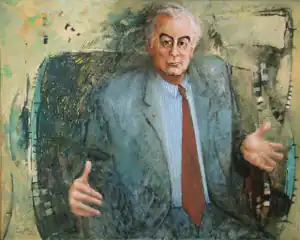| The Hon E.G. Whitlam | |
|---|---|
 | |
| Artist | Clifton Pugh |
| Year | 1972 |
| Medium | oil on composition board |
| Dimensions | 113.5 cm × 141.5 cm (44.7 in × 55.7 in) |
| Location | Parliament House, Canberra |
The Hon E.G. Whitlam is a 1972 portrait painting by Australian artist Clifton Pugh. The painting depicts Gough Whitlam, 21st Prime Minister of Australia. The painting was awarded the 1972 Archibald Prize.[1] Pugh had won the same prize the year before for a portrait of Australia's 18th Prime Minister John McEwen.[2]
Art critic Sasha Grishin describes the painting as "outstanding for its vibrancy, expressive characterisation and energetic brushwork."[3]
Pugh was sometimes described by contemporaries as "the court painter to the [Australian] Labor Party (ALP)."[4] Pugh started the work before Whitlam was elected the ALP Prime Minister in 1972. He told journalist Laurie Oakes that Whitlam "keeps a cover on himself and seldom relaxes. I’m having a hard job to decide just how to paint him, to decide what sort of man he really is."[5]
In the end, after a dozen false starts, [Pugh] decided Whitlam was strong and confident, though with an eye more on a place in history than on the present, and painted him that way
After Whitlam's dismissal from office by the Governor-General, Whitlam refused to sit for an official portrait to sit in Parliament House and requested that Pugh's portrait be hung instead. This offer was accepted and the portrait remains part of the Parliament House collection.[6]
References
- ↑ "The Hon EG Whitlam". Archibald Prize. Art Gallery of New South Wales. Retrieved 28 August 2020.
- ↑ "Sir John McEwen". Archibald Prize. Art Gallery of New South Wales. Retrieved 31 August 2020.
- ↑ Grishin, Sasha (29 October 2018). "How (not) to paint a prime minister". Grishin's Art Blog (GAB). Retrieved 28 August 2020.
- ↑ "Portraits of a more relaxed time for those on the hill". Sydney Morning Herald. 9 December 2005. Retrieved 28 August 2020.
- 1 2 Oakes, Laurie (24 October 2014). "Gough Whitlam: Portrait of a risk taker". Daily Telegraph. Retrieved 28 August 2020.
- ↑ "Historic Memorials Collection". Parliament House. Retrieved 28 August 2020.